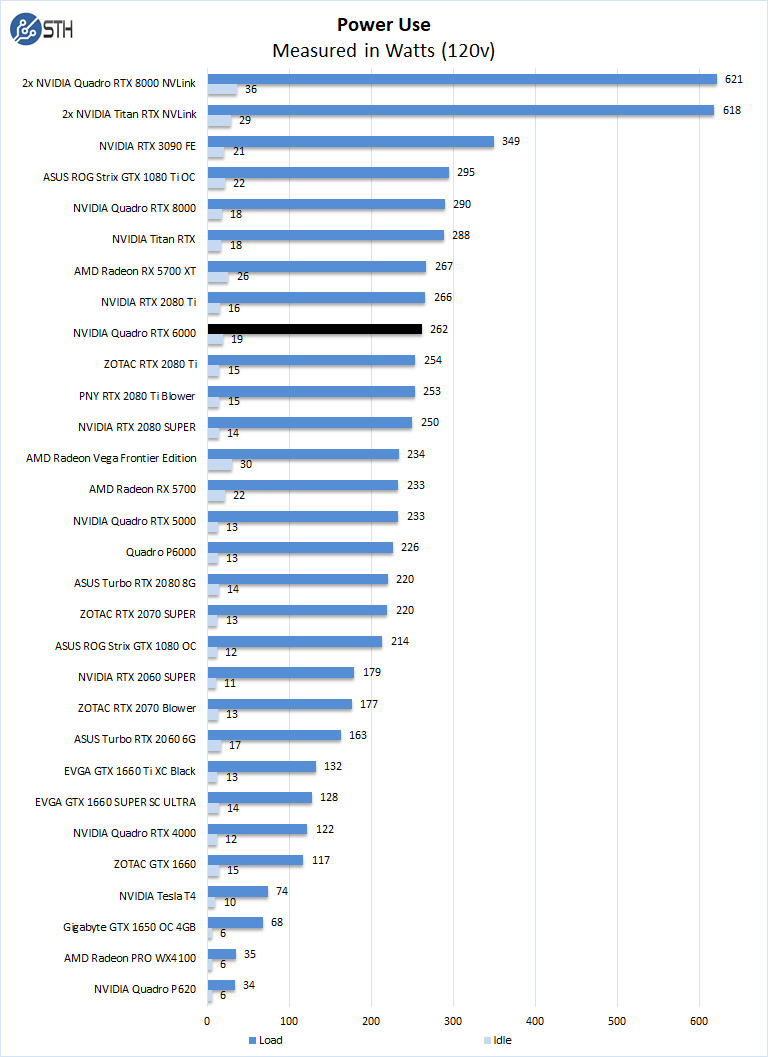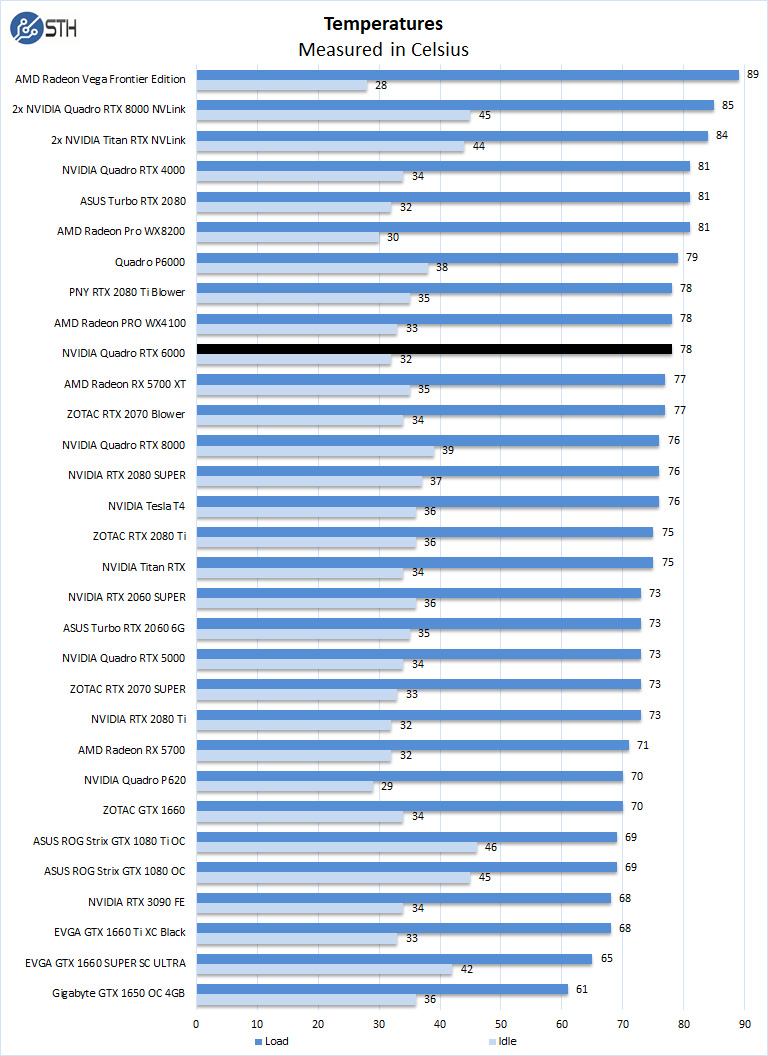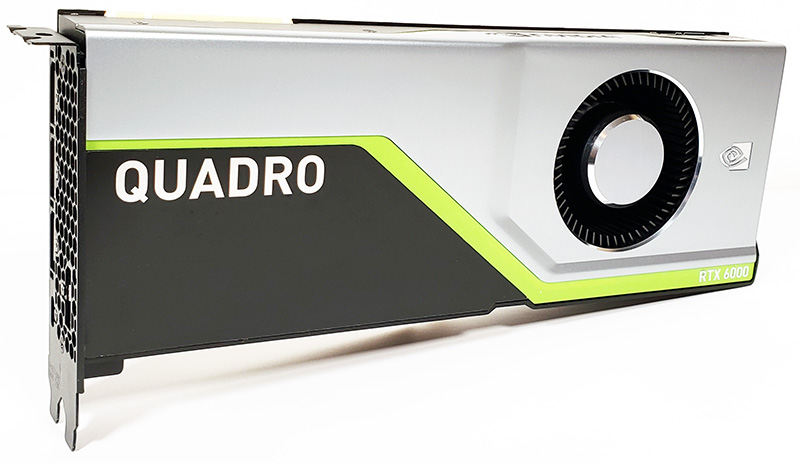Power Tests
For our power testing, we used AIDA64 to stress the Quadro RTX 6000, then HWiNFO to monitor power use and temperatures.

After the stress test has ramped up the Quadro RTX 6000, we see it tops out at 262 Watts under full load and 19 Watts at idle.
Cooling Performance
A key reason that we started this series was to answer the cooling question. Blower-style coolers have different capabilities than some of the large dual and triple fan gaming cards.

Temperatures for the Quadro RTX 6000 ran at 78C under full loads, which shows NVIDIA’s new cooling solution performs very well and makes very little noise. Idle temps we saw were 32C, which is also excellent for a GPU of this size.
Final Words
After all of these benchmark runs, there are a few themes that tell the story of the Quadro RTX 6000. First, one way to look at this card is a Titan RTX rival with a blower-style cooler adding ISV certified driver support for a larger price tag. Another way to look at this card is that it is a Quadro RTX 8000 competition that trades half the memory capacity for a lower price. If you want to densely pack GPUs into a server or workstation the blower-style cooler works well and the fact that there is a passively cooled version of the card that we saw in our ASUS ESC4000A-E10 2U AMD EPYC GPU Server Review makes for a lot of deployment flexibility.
Then, there is the big question. Aside from the blower-style cooler and the ISV certified drivers, for those who are just looking for 24GB of memory and compute performance for 1-2 cards per system, the NVIDIA GeForce RTX 3090 simply offers more for much less. The new A6000 series 48GB GPUs are just starting to ship as we are finishing this review. Perhaps it is a symptom of timing where we are reviewing this card at the end of a cycle. Still, with the previous Titan RTX the price/ performance outside of the realm where the ISV certified Quadro/ enterprise drivers are required seems lacking.

If we had reviewed the Quadro RTX 6000 closer to launch, it would have been an excellent card comparing it to the Pascal generation. Taking stock of where it is in today’s market, after the Turing generation and now Ampere has arrived, it seems like a card that has lost a lot of the allure it once had for desktops and workstations, assuming one does not need those ISV certifications to get support for costly professional applications. On the other hand, the fact that we see the A6000 dropping the Quadro branding, and we also see a passively cooled version of the Quadro RTX 6000 means that this seems to have found another market during its lifetime. For compute purposes, this seems like it has become a PCIe alternative for GPU compute cards where Turing and lower cost per GPU was desired over Volta. With OEM discounts and NVIDIA rebates, the cost of these cards can be much closer to a Titan RTX but with form factors that are much more suitable for dense configurations. If we look not just at the card we saw in this review, but also the cards such as the passively cooled versions in the GPU compute server, we can see how this card evolved over its lifetime. To us, this is still a good card assuming discounts are healthy, but as the Ampere generation arrives in obtainable quantity, we expect the market to shift in that direction.




One of the big differences between the RTX Titan and the RTX 6000 is the ability to RDMA, aka, GPU-Direct DMA between machines.
I’d love to see that tested using Mellanox RDMA ConnextX 5 or higher cards on a 25, 40 or 100gb VPI or ethernet connection.
@Larry Barras
I’ve a dual 2080ti machine in a network that runs gig-E and QDR Infiniband. I have to explicitly tell NCCL to not look on the IB network for peers. So, I think you may be able to do RDMA with the gamer cards too.
No, none of the “consumer” range cards can do GPU-direct DMA, not even the Titan RTX. I’ve tried directly in the API and no dice, period. The RTX2080ti definitely will not, the API always returns an error code of “no permission/feature unsupported”.
@Larry
Ah, OK then. Good to know.
Hey guys!
Not sure what is up with that Octane benchmark guys but I think you should recheck the data you’ve gathered so far.
Given all the other reviewers and the official benchmark results page on Otoy’s page an RTX 2080ti performs about the same as the Titan RTX. The 3090 is typically about 2x as fast as the 2080ti in that benchmark – not quite the difference you’ve benchmarked.
Seems like something is super off there as the benchmark isn’t VRAM limited and so even a 2080 should be positioned a lot differently.
Are you sure you are running the latest benchmark? I can’t seem to reproduce these results on my end at al..